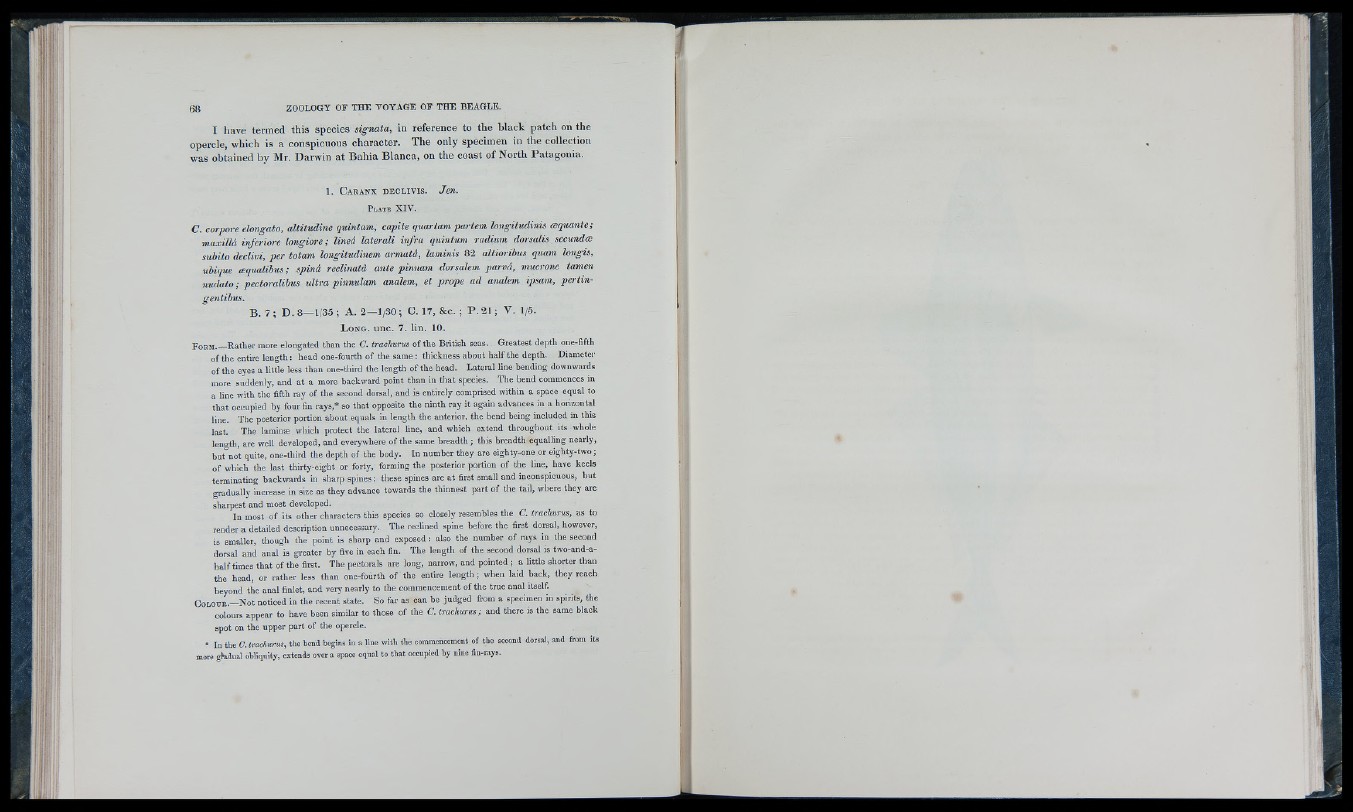
I ’h !
I have termed this species signata, in reference to the black patch on the
opercle, which is a conspicuous character. The only specimen in the collection
was obtained by Mr. Darwin at Bahia Blanca, on the coast of North Patagonia.
1. C a b a n x d e c l i v i s . Jen.
P l A T H XIV .
C. corpore elongato, altitudine quintam, capite quartam partem longitudinis alquante;
maxilU inferiore longiore ; linea laterali infra quintum radium dorsalis secundre
subito declivi, per totam longitudinem armatá, laminis 82 altiorilms quam longis,
ubique aqualibus ; spina reclinata ante pinnam dorsalem parvà, mucrone tarnen
nudato ; pectoralibus ultra pinnulam analem, et prope ad analem ipsam, pertin-
B. 7 ; D. 8— 1/35 ; A. 2—1/30; C. 17, &c. ; P . 21 ; V. 1/5.
L ong. unc. 7. lin. 10.
PoBM.—R ather more elongated than the C. Irachurus of the British seas. G reatest depth one-flfth
of the entire len g th ; head one-fourth of the same ; thickness about h alf the depth. Diameter
of the eyes a little less than one-third the length of the head. Lateral line bending downwards
more suddenly, and a t a more backward point than in that species. The bend commences in
a line with the fifth ray of the second dorsal, and is entirely comprised within a space equal to
th a t occupied by four fin rays,» so that opposite the ninth ray it again advances in a horizontal
line. The posterior portion about equals in length the anterior, the bend being included in this
last. The laminic which protect the lateral line, and which extend throughout its whole
length, are well developed, and everywhere of the same breadth ; this breadth equalling nearly,
b ut not quite, one-third the depth of the body. In num ber they are eighty-one or eighty-two ;
of which the last thirty-eight or forty, forming the posterior portion of the line, have keels
terminating backwards in sharp spines; these spines are a t first small and inconspicuous, but
gradually increase in size as they advance towards the thinnest part of the tail, where they are
sharpest and m ost developed.
In most of its other characters this species so closely resembles the C. trachurus, as to
render a detailed description unnecessary. The reclined spine before the first dorsal, however,
is smaller, though the point is sharp and exposed ; also the number of rays in the second
dorsal and anal is greater by five in each fln. The length of the second dorsal is two-and-a-
h alf times that of the first. The pectorals are long, narrow, and pointed ; a little shorter than
the head, or rather less than one-fourth of the entire len g th ; when laid back, they reach
beyond the anal flnlet, and very nearly to the commencement of the true anal Itself.
C o L O n E . — N ot noticed in the recent state. So far as can be judged from a specimen in spirits, the
colours appear to have been similar to those of the C. tradm rus; and tliere is the same black
spot on the upper part of the opercle.
* In the C. trachurus, the bend begins in a line with the commencement of the second dorsal, and from its
more giadual obliquity, extends over a space equal to that occupied by nine fin-rays.